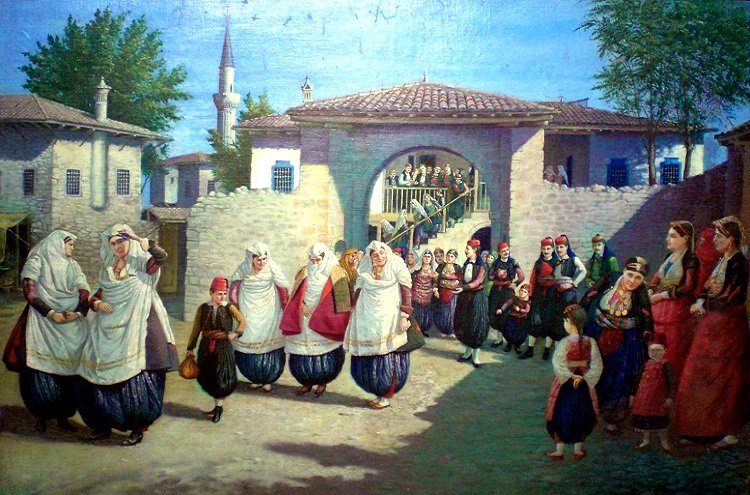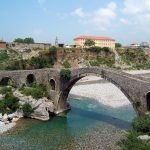
Albanian Paintings: Top 10 Masterpieces to Discover in Albania
Albanian paintings date back since ancient times but names of artists appear only during Medieval times. From then this art has developed with interruptions and suppression, with iconic paintings leaving their marks in national identity; here are the top Albanian paintings of all times.
1. Sister Tone (Motra Tone), 1883 – Kolë Idromeno (1860-1939)
The portrait “Motra Tone” is Albania’s Mona Lisa. Completed in 1883, it’s the masterpiece of Kolë Idromeno and the most iconic painting of Albanian art. The woman depicted, sister of the artist herself, is dressed in traditional, national costume, and looks timidly on her left. Her white veil gives light to the portrait and contrasts the dark background.
The painting reflects the important position of women in the Albanian household transmitting both vulnerability and pride. Even though the painter did this work at a young age, it had turned into a masterpiece in time and a symbol of the Albanian National Renaissance in art.
Stands in: National Art Gallery, Tirana.

2. Saint Mary with Jesus (Shën Maria me Jezusin), 1540s – Onufri (1500-1578 ?)
This icon stands in the Cathedral Church of the Assumption of Saint Mary within the walls of the Berat castle. The site currently serves as the Iconographic Museum “Onufri” dedicated mainly to the iconostasis of Onufri. The author completed this work sometime during the 1540s when he was active in Berat. The icon best reflects Onufri’s realism, elegance, and fine combination of expressive colors, even though it deals with a religious theme.
For many critics, this icon marks a cornerstone in the development of Albanian art. The icon was composed in a time when the Ottomans had already crushed the Albanian Resistance and conquered their territories. Thus, Onufri may have tried to emulate with his works the pre-Ottoman vibe of the region.
Stands in: National Iconographic Museum “Onufri”, Berat.

3. The Dove (Pëllumbi), 2005 – Helidon Haliti
This oil painting is part of Haliti’s pictorial cycle reflecting the spiritual distemper an immigrant, as he is, had to face. This work transmits a dramatic fable using powerful colors and astonishing craftsmanship. The painting stands at Mezuraj Museum in Tirana; many other modern Albanian artists are part of the interesting modern generation of Haliti.
Stands in: Mezuraj Muze, Tirana.


4. Landscape (Peizazh), 1919 – Vangjush Mio (1891-1957)
This landscape painting of Mio is a blend of oil colors reflecting a marshy and turbulent scene. The painter has clearly used his brush to create the turbulence that dominates his work. This painting is one of the earliest works of Vangjush Mio that paved the way to his later landscape paintings with a similar impressionist feel.
Stands in: National Art Gallery, Tirana.


5. Scanderbeg (Skënderbeu), 1931 – Spiro Xega (1876-1953)
This equestrian painting of Skenderbeu is one of the most famous paintings of Spiro Xega. It shows the national hero of Albania as an “Albanian Napoleon”. The hero is charging his horse in the battlefield with confidence while carrying a jatagan. This remains one of the most memorable portrayals of Gjergj Kastrioti in figurative arts.
Stands in: National Art Gallery, Tirana.
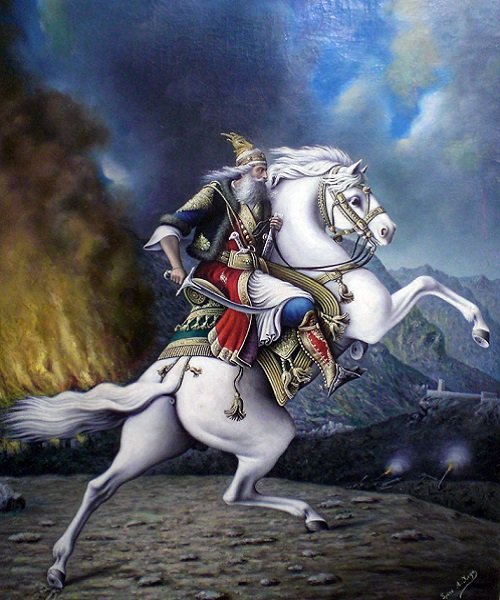
6. Saint Demetrius on horse (Shën Dhimitri në kalë), XVIII century – Kostandin Shpataraku (1736-1767)
This icon known as “Saint Demetrius on horse” is attributed to Kostandin Shpataraku, an Albanian painter from Shpat near Elbasan, active in 1736-1767. This icon, along with other works of Shpataraku, are a continuation of Onufri’s painting style. The depiction, showing Demetrius on horse killing a defeated enemy seems to be an allegory on the fall of the Bulgarian ruler Kaloyan during his besiege of Thessaloniki.
Kaloyan was actually killed by one of his own, but this icon inspires those who believe that Saint Demetrius, protector of Thessaloniki, intervened and saved the city. In 2010, the icon, up until then part of the collection of the painter Alush Shima, was bought in auction for 75,000 Euros.
Stands in: National Iconographic Museum “Onufri”, Berat.

7. Portrait of a Woman (Portret Gruaje), 1933 – Zef Kolombi (1907-1949)
This fine and bright portrait stands in the National Art Gallery in Tirana. Observers can feel a sense of delight as well as melancholy in the beauty of the young woman. This painting of Kolombi offers valuable insight on the evolution of portrait painting in Albania.
Stands in: National Art Gallery, Tirana.
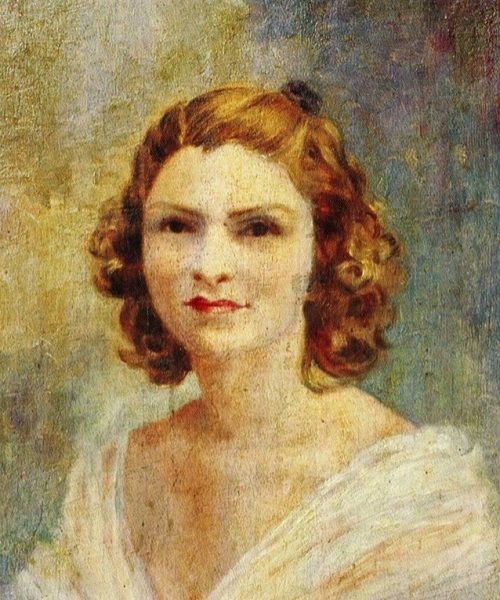
8. Saint Nicholas saves the mariners (Shën Kolli shpëton detarët), 1721-1726 – David Selenica (late XVII – XVIII century)
This mural painting is part of a whole visual decoration inside the Saint Nicholas Church in Voskopoja. The painter responsible for this entire decoration was David Selenica. The painter completed the work on this church during 1721-1726. As in countless other works, the painter from the region of Vlora used bright colors in his works and laic scenes within religious frames, combining elements of the Paleolog-Byzantine era with the contemporary art school of the Venetian Republic.
Stands in: Church of Voskopoja
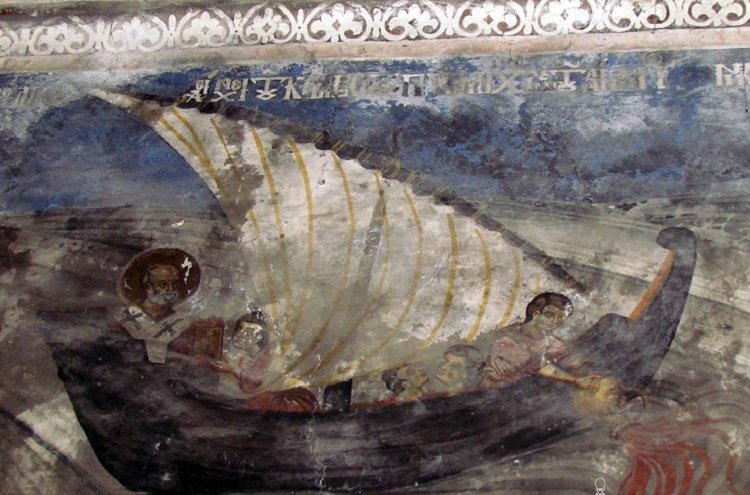

9. Bazaar of Kruja (Pazari i Krujës), 1960 – Sadik Kaceli (1914-2000)
This painting of the charismatic Sadik Kaceli shows the monumental town of Kruja as an impressionist sketch. This is one of the finest examples of Kaceli moving away from the rigid and despotic norms of social realism. Thus, for a long time during the dictatorship, works of Sadik Kaceli were ignored in favor of more appropriate propaganda.
Stands in: Kaceli Collection
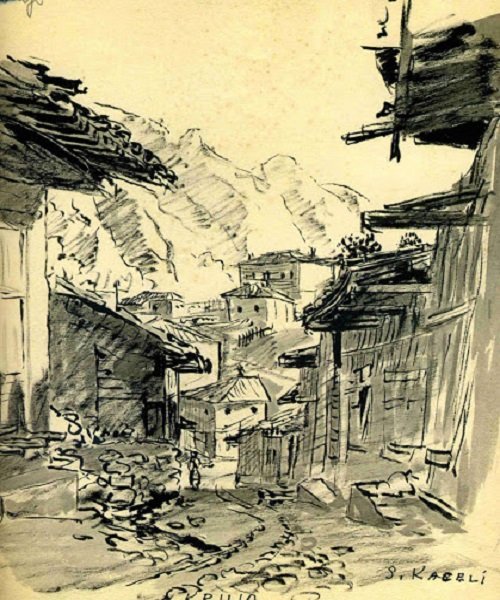
10. Wedding in Shkodra (Dasma Shkodrane), 1924 – Kolë Idromeno (1860-1939)
The painting is composed as a tribute to the Albanian wedding ceremonial. The painting frames the most emotional part of an Albanian wedding ritual: the escort of the bride from her house. The joy of the family members, neighbors, and participants is easily noticed thanks to Idromeno’s amazing skills. The tableau was completed in 1924 after having received five years of detailed and delicate work. The painting is rightly called an “ethnographic treasure” of the Albanian art.
Stands in: National Art Gallery, Tirana.
